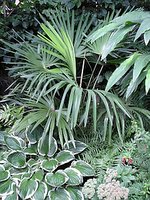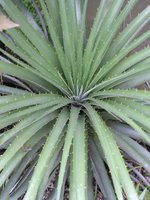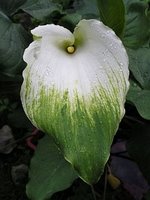
Allthough the list of Palms which are hardy or nearly so seems to lengthen year by year, most people seem to start of with one of the "Old Faithfulls", usually T.Fortunei. As nice as this palm is, it's easy to grow and suffers little from pests, it does have one great failing. Wind! In anything more than a modest breeze, the leaves can end up being almost shredded to bits and come the spring it looks like a bomb has hit it. This of course can be very off putting to someone who doesn't know too much about palms. There are however, other Trachy's which are more resilient to the attentions of the umbrella basher.
One of course is T.Wagnerianus, a bomb proof palm if ever there was one, here's another one T. Latisectus, the Windamere Palm.
T.Latisectus used to be known as T.Sikkimensis, which makes sense because it comes from the Sikkim Himalayas. In their wisdom, the experts have decided to rename it Latisectus. One day I might find out why they do these things. ( Plant experts and botanists, who change the names of whole family's of plants, always remind me of the pop star known as "Prince" or more correctly "Formerly known as Prince" who is probably now "Joe Bloggs". I'm sure when they get up in the morning, they're on the phone to their mates saying something like "I've a good idea, lets call a daisy an orchid and confuse everyone". ) Anyway back to T.Latisectus.
There are only two areas in my garden which can reasonably be described as nearly wind free, the north east corner and the south west corner. T.Latisectus lives in the n.east bit. Compared to a T.Fortunei which grows a few yards away it's larger in all its parts. The leaves are longer and broader and form almost a complete circle. Adverse weather seems to have little effect on it and there's hardly any wind damage to the leaves. I've never found any pests on it, even the vine weevils which infest some areas of my garden leave it well alone. ( I told em one night "Touch my Lati and I'll av ya!" )
One thing I've noticed, is that after being planted out it does seem to be a bit slow getting back into growth mode. Have a bit of patience though because once it gets started there's no stopping it. For anyone who grows palms, be they newcomer or expert I'd recommend T.Latisectus. It looks good, nay great, it's easy to grow, pests seem to leave it alone and if you worry about growth rates ( I don't, too old ) once it gets going, hang on to your hat. Well, nearlyanyway. Posted by: Mike.
Note: For a more comprehensive explanation of how I plant my palms, go to my June blog:

One of the most satisfying aspects of growing exotics, is when one of your plants exceeds your expectations and comes through the winter successfully
I have several plants, which according to the information I've managed to find out about them should have gone to that Great Garden in the Sky a long time ago, but come the spring they're still with me and looking good. These are my "Gem Plants" and Puya Alpestris is one of them.
The first thing that strikes you about this plant is its resemblance to a giant Pineapple top. Which is not surprising as it's a member of the same family. The second thing, if you're not carefull, will be to make the acquaintance of the spine's that run along the leaf edge's. These are shaped like sharks teeth and are vicious looking things. ( And they're sharp! I know.) Don't let this put you off, because it's a plant well worth growing, just keep it away from kids and dogs.
P.Alpestris grows at high altitudes in the Chilean Andes and it will grow in full sun ( recommended ) or light shade. Fast drainage is a must as its water requirements are low and any excess water around the roots could cause problems.
Although it can be grown in a pot, in fact that's how I grew it for the first year, it isn't something I'd recommend. This is a bulky plant and tends to blow over easily, you also have the problem of handling it and this can be nerve racking. However, if you want to try it, use a one to one mix of J.I.No2 and gravel.
I've had my plant for five years now and it's been planted out for four of them. It grows in a small gravel bed in a south facing position where I used to grow some choice Alpines. Apart from bringing it indoors the first winter, I've never given it any winter protection and apart from the odd pale spot which sometimes appears on the leaves I've had no problems with it at all. Even the bugs, slugs and other "Pain in the Bums" leave it alone. In the spring and midsummer I give it a couple of doses of half strength tomato fertilizer and sequestered trace elements and that's it. I leave the rest to the Gardening Gods and Nature. All in all, a great plant. Posted by: Mike.
Footnote. Although there are several varieties of Puya available to the enthusiast, I've only seen P.Alpestris for sale at Trevena Cross Nurseries. So if you want to give it a try, go to the link's column and click on www.trevenacross.co.uk.
From mountain and valley, veldt and fynbos. Over the years, South Africa has given the gardening world a host of fine plants. Many of these fall into the half hardy or tender category, here's one that doesn't. At least not for me!
Zantedescha Aethiopica "Green Goddess" is one of my favourite plants, adding a touch of colour that gives a lift to the "Jungle" type garden but without overpowering it. The splash of white on the green spathe lifts it out of the ordinary and to see a plant with a dozen stems in flower is a sight to behold. There are several cultivars available and I've recently bought one called "Kiwi Blush" which I'm looking forward to seeing in flower.
Growing in sun or shade Z.Aethiopica is a versatile plant. It can be grown as a marginal plant, a border plant and potted up it makes a very good house or conservatory plant. As a marginal, it's best grown in a basket in aquatic soil. This can then be placed in your pond anything up to 12 inches deep. If you live in a very cold area, or your pond is shallow it's best if you lift it in the autumn, pot it up and grow it on as a houseplant.
For use as a garden plant you need a rich soil. Mix in plenty of well rotted compost or manure, give it plenty of water and lots of low nitrogen fertilizer. Avoid using high nitrogen fertilizers or you'll end up with a lot of leaf growth at the expense of the flowers. I use tomato or rose fertilizer. A good mulch of well rotted manure can be used to give winter protection.
To grow in a pot I use a mix of J.I.No3, well rotted manure, gravel and long life fertilizer pellets. I also give it a few doses of tomato fertilizer to help things along. If you're wandering why I mix in the gravel when the plant likes a lot of moisture it's because root's need air and gravel helps provide the air spaces. This also lessens the chance of root and tuber rot developing.
Z.Aethiopica is a tuberous rhizome and dividing it into sections provides us with the easiest and quickest way of propagating more plants. This is the method I use. Your plant needs to be dormant by the way. I lift the plant in the spring, usually the end of March. All the soil is washed off leaving a good clean tuber. I look for any damage or signs of rot. Any part of the tuber that is suffering from rot is cut away and binned, treat all cut surfaces with sulpher or Cheshunt Compound. I then place the tuber in a tray of barely moist peat or compost. It doesn't need any great heat, about 60f. will get things moving. After a few weeks, you should see new growth buds emerging. The next step is to divide the rhizome into sections. Use a sharp knife or scalpel and make the cut's clean. Make sure all the division's have at least one growth bud. Dust all cut's with sulpher or Cheshunt Compound. I usually leave the divisions in a warm spot overnight to allow any excess moisture to evaporate. Pot up in a very well drained, moist compost mix. I always stand my pots in a tray and water them from below, after a few minutes I remove the pot's and let them drain off. Placed in a warm area you should soon see new growth coming up. Whatever you do don't over water them. Keep the division's on the dry side until you see a decent amount of growth. Only then should you start to water more freely. If divided early enough, they should flower in the same year.
Zantedeschia species and the cultivar "Green Goddess" can all be grown from seed. I use a compost mix of one to one Perlite and soilless compost. If the seeds are fresh they can be planted immediately, I put one in a three inch pot with a topping of Vermiculite. Older seeds, I soak in water for a couple of days, giving them a swill in running water after 24hrs and another one prior to potting them up. This rehydrates the seed should help wash out any chemical inhibitors. The seeds are then potted up. I don't have a propagator so I put them in a warm room and let nature take its course. Here again, don't go mad with the water, just moist is fine. You can use a weak mixture of high nitrogen fertilizer to speed up the growth of the tuber. After a couple of years, your tuber should be close to flowering size. Stop using the nitrogen fertilizer and switch to one with a high potash content. This is the one which will give the flowers and the feeling of satisfaction you'll get when you see it in bloom. You'll find it takes about three to four years from seed to flowering so you'll need to be patient. All in all a lovely plant, which apart from the odd suicidal slug is trouble free. Posted by: Mike.
Over the coming year I will be publishing blogs about growing exotic plants and some which look exotic but are hardy. This will include those that I'm growing now, those that I've tried to grow and some I've given up on. I'll be covering cultivation, propagation and after care. Where possible I'll include photos in glorious colour. ( Thanks to my all singing, all dancing NEW digital camera. Now! How do I open this box? )
Comments, criticism and suggestions are welcome ( Nothing rude or painfull please ).
If you'd like to contribute a blog, e. mail it to me and I'll put it on the site. My e. mail address is: bhutia2006@hotmail.co.uk
Good Growing. Posted by: Mike.
The lack of heavy Autumn/Winter rain has left the garden looking very dry and for the first time ever I've abandoned giving it the usual Spring mulch.
What little rain that has fallen since simply evaporates at the first hint of sunshine.
I also recorded the lowest temperatures for four years, down to -10c. This froze everything including me to the core.
Along with this we had the usual bitterly cold north and easterly wind's and several day's of "Pea Souper" freezing fog.
All we needed was a good snow storm and we would have been back to the winters of old.
Unfortunately I also had some plant casualties.
Three small Phoenix Canariensis, Chamaerops Humilis v Cerifera and a Trachycarpus Nanus have all gone. These were in pots and I'd stored them in a temporary shelter which I put up every year. This isn't frostproof it just keeps excess rain off.
Also doubtful is a Musa Sikkimensis which I planted out three years ago.
A couple of Agave Americana, one green and one blue have also suffered a bit but the growing point and stem are o.k. so they should pull through.
Reading this you might think its all doom and gloom. Fear not, there are plenty of good bits!
Trachycarpus Latisectus, T.Fortunei and C.Humilis which are planted out are all o.k. allthough the leaves on T.Fortunei took something of a clobbering. ( Nothing new there.)
I have two T.Wagnerianus growing in large decorative pots which have also come through unscathed. Chamaedorea radicalis is the only palm I give any protection to and that is just a wrap around of fleece to protect it from wind damage, the rest have to sink or swim.
Finaly, Butia Yatay and Brahea Armata, both in pots and overwintered under the shelter have come through as well. Posted by: Mike.




